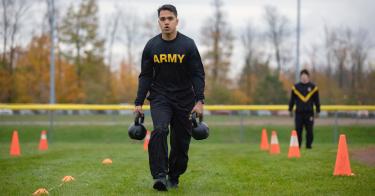Physical fitness is a cornerstone of military readiness. Historically, this quality has helped American servicemembers fight and win over numerically superior enemies.
Nevertheless, Congress has rarely taken much interest in a service’s military physical fitness testing—until now.
On Thursday night, the Senate approved its version of the National Defense Authorization Act (NDAA). Section 557 of that bill would scrap the current Army Combat Fitness Test and replace it with the old Army Physical Fitness Test. Meanwhile, the House version of the NDAA proposes requiring a gender-neutral fitness test for combat arms positions.
In both cases, the issue is to ensure that fitness standards are not compromised for reasons unrelated to war-fighting.
On the battlefield, physical fitness can be the difference between life and death. For four decades, the Army’s fitness test consisted of two minutes of pushups, two minutes of sit-ups, and a two-mile run. But the inadequacies of this test proved glaring in Afghanistan and Iraq, where soldiers frequently suffered exoskeleton injuries as a result of their lack of holistic fitness.
>>> Obesity Epidemic Threatens Not Just Public Health, but Also National Security
This led the Army to attempt to find a test that would better evaluate fitness. After much research and testing, they finally did: the Army Combat Fitness Test (ACFT).
The ACFT is more comprehensive than the old test, encompassing 10 aspects of physical fitness. It evaluates muscular strength, endurance, power, speed, agility, coordination, flexibility, balance, reaction time, and aerobic capacity. The old test measured only two of these—muscular endurance and aerobic capacity.
The ACFT’s criteria are also designed to simulate physical activities needed in combat—for example, dragging a wounded comrade (sled drag) or moving ammunition containers (kettlebell carry).
The ACFT was developed both to increase overall fitness and to assess whether soldiers can meet the needs of certain demanding combat positions. The latter took on greater importance in January 2016, when then-Defense Secretary Ash Carter opened all military occupations and positions to women.
Thus, the ACFT was designed to provide gender-neutral physical standards based on different military occupational specialties. Indeed, in 2021, Army Chief of Staff Gen. James McConville testified to Congress that he was committed to gender-neutral testing.
In spite of this, the Army abruptly scrapped its plan for gender-neutral testing and lowered the minimum passing standards for the pushups and running. The change came after large percentages of female recruits were not passing the ACFT.
When asked about this change, Secretary of the Army Christine Wormuth responded that the Army did not want “unfair standards” for “a particular subgroup” that “couldn’t perform.”
Concerned about the implications of this change on warfighting, Sen. Tom Cotton (R-Ark.) subsequently introduced legislation in the FY 2023 NDAA requiring the Army to implement a gender- and age-neutral fitness standard for combat jobs by June 2023. The Army, however, took the position that it was already in compliance with the law and therefore “unlikely” to make additional changes to the test.
This brings us to the current situation. The Senate provision requiring reversion to the old test has served as a “wake-up call” to the Army that the status quo is unacceptable. It has certainly gotten the Army’s attention.
Meanwhile, the House version of the bill contains a requirement similar to the one originally established in the 2023 NDAA, where an “enhanced” gender-neutral standard would be created for combat roles only. The rest of the Army would still maintain the current ACFT requirements.
>>> Biden’s Pentagon Can’t Recruit New Soldiers and That Threatens Us All
Combat is unforgiving. A focus on achieving gender “equity” in combat formations, rather than attaining scientifically established fitness standards, will put the Army on the path to ruin.
Senate frustration with the Army is understandable. The proper path here, however, is not to revert to the old test, but instead to establish gender-neutral standards for the Army’s physically demanding occupations, which should be determined by the actual requirements of the positions.
For example, artillery soldiers are often required to handle shells that weigh more than 90 pounds. But this ability is not necessary for a computer specialist.
Congress is playing an important role here. In the end, there must be a way to ensure that soldiers have the proper levels of fitness to perform their jobs, while at the same time, providing maximum opportunity for as many people to serve as possible. The Army Combat Fitness Test, with its six criteria, is a superior measure to the previous test and its three criteria.
And gender-neutral tests with standards for combat occupations is necessary for all the services, not just for the Army. Encouragingly, in his recent confirmation hearing, the nominee to be the next Chief of Staff of the Army, Gen. Randy George, committed to just that.
National defense is the most important priority for the federal government, and its fitness standards must reflect this. The 2024 National Defense Authorization Act should codify this requirement.
This piece originally appeared in The Hill on 8/3/2023



